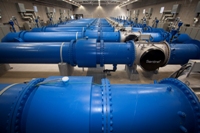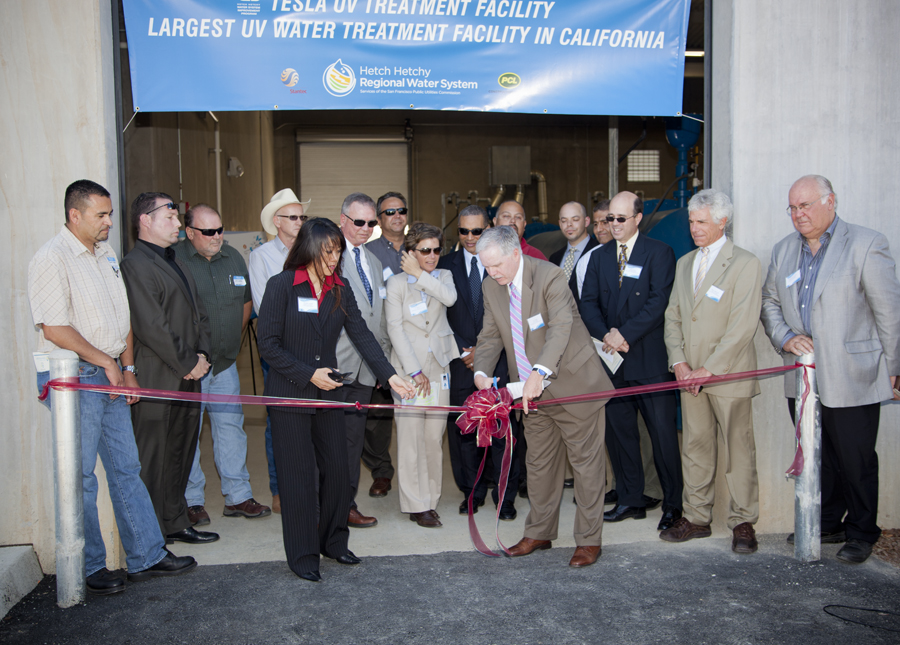
Focus On: California's Largest Ultraviolet Water Treatment Facility

On July 19, 2011, the San Francisco Public Utilities Commission (SFPUC) General Manager Ed Harrington was joined by State and Federal officials to dedicate the new state-of-the-art Tesla Water Treatment Facility in Tracy, Calif.
With a capacity of treating 315 million gallons of water per day, this new $114 million ultraviolet water treatment facility is now the largest-capacity facility of its kind in California and the third largest in North America.
“The San Francisco Bay Area already receives pristine Hetch Hetchy water that comes from Sierra Nevada snowmelt,” Harrington said. “The Tesla facility simply makes this great water, even better.”
Also noteworthy is that this facility is being commissioned nine months before the Environmental Protection Agency (EPA) establishes a new requirement for a second disinfectant for all unfiltered drinking water systems in the nation. Advanced disinfection using ultraviolet light adds another level of protection to the water quality of the Hetch Hetchy Regional Water System that serves 2.5 million Bay Area residents.
“This project shows how local water agencies are taking a leadership role by investing in vital water infrastructure. The public values and expects safe, reliable water at the tap. These investments benefit the state and serve as important examples for other agencies to follow,” said Timothy Quinn, executive director of the Association of California Water Agencies (ACWA).
Technical Insight, Safety and Sustainability
The new facility system features isolation valves and piping to divert water flow into the new treatment facility, large-diameter piping and valves within the facility, and a single discharge pipeline to tie back into the existing pipelines. This new facility replaces the functions of the 75-year-old Tesla Portal Disinfection Facility, which no longer meets present-day fire or earthquake safety standards.
The ultraviolet (UV) disinfection building houses 12 Sentinel Chevron 48 UV reactors, with an additional two on site but on standby, as well as cleaning and ancillary equipment. The facility’s chemical storage and feed building includes sodium hypochlorite and hydrofluosilicic acid, while carbon dioxide is used for pH correction. By using UV equipment, the new facility provides enhanced treatment against waterborne pathogens as well.
UV light is generated by specially designed lamps that emit energy in the germicidal wavelengths. In addition, the water will receive pH correction and fluoridation at this facility prior to delivery to customers.
“It’s like a tanning salon, except if you were a microorganism, you’d be fried in the second,” said Bruce Macler, a toxicologist with the EPA. “It’s just light, but it burns them up.”
The SFPUC’s water quality manager, Andrew DeGraca, explained, “Hetch Hetchy’s clean water can first be attributed to the lack of livestock and large number of humans found around Hetch Hetchy. Thanks in part to the water’s initial cleanliness, San Francisco has never experienced a major outbreak of a waterborne illness.”
Targeting Silver LEED Certification
The Tesla Facility was designed with sustainability in mind. To this end, the facility is pursuing a silver-level LEED certification and is expected to qualify.
Among the sustainable features of the new facility, the Tesla Facility includes considerable waste management and recycling components as well as xeriscape plants for landscaping that minimize water use. The new sampling system allows operators to return clean water back to our San Joaquin water delivery system, reducing the amount of water wasted. Several energy performance elements are also included with regards to lighting and screening.
Design-Build Partners: PCL Civil Constructors Inc. and Stantec Consulting Inc.
The Tesla Treatment Facility is the only design-build construction project among 86 projects included in the SFPUC’s Water System Improvement Program (WSIP). Work for this project was performed by PCL Civil Constructors Inc. and Stantec Consulting Inc., an architecture and engineering firm.
Throughout a two-year design-build effort, PCL and Stantec worked in partnership to design and build a facility that would meet and exceed the EPA’s Long Term 2 Enhanced Surface Water Treatment Rule. The team began facility design and equipment procurement in 2008. Stantec completed initial designs for the SFPUC in eight months, and construction began in April 2009. The entire project was completed in a record 28 months, and substantial completion was issued in June 2011.
Water System Improvement Program
Built in the early to mid-1900s, many parts of the Hetch Hetchy Regional Water System are nearing the end of their working life, with crucial portions crossing over or near to three major earthquake faults. The $4.6 billion WSIP was launched in 2002 to repair, replace and seismically upgrade aging pipelines, tunnels, reservoirs and other water delivery facilities. The overall program, which includes more than 80 projects, is currently on budget and scheduled for completion in 2016.
On July 19, 2011, the San Francisco Public Utilities Commission (SFPUC) General Manager Ed Harrington was joined by State and Federal officials to dedicate the new state-of-the-art Tesla Water Treatment Facility in Tracy, Calif.
With a capacity of treating 315 million gallons of water per day, this new $114 million ultraviolet water treatment facility is now the largest-capacity facility of its kind in California and the third largest in North America.
“The San Francisco Bay Area already receives pristine Hetch Hetchy water that comes from Sierra Nevada snowmelt,” Harrington said. “The Tesla facility simply makes this great water, even better.”
Also noteworthy is that this facility is being commissioned nine months before the Environmental Protection Agency (EPA) establishes a new requirement for a second disinfectant for all unfiltered drinking water systems in the nation. Advanced disinfection using ultraviolet light adds another level of protection to the water quality of the Hetch Hetchy Regional Water System that serves 2.5 million Bay Area residents.
“This project shows how local water agencies are taking a leadership role by investing in vital water infrastructure. The public values and expects safe, reliable water at the tap. These investments benefit the state and serve as important examples for other agencies to follow,” said Timothy Quinn, executive director of the Association of California Water Agencies (ACWA).
Technical Insight, Safety and Sustainability
The new facility system features isolation valves and piping to divert water flow into the new treatment facility, large-diameter piping and valves within the facility, and a single discharge pipeline to tie back into the existing pipelines. This new facility replaces the functions of the 75-year-old Tesla Portal Disinfection Facility, which no longer meets present-day fire or earthquake safety standards.
The ultraviolet (UV) disinfection building houses 12 Sentinel Chevron 48 UV reactors, with an additional two on site but on standby, as well as cleaning and ancillary equipment. The facility’s chemical storage and feed building includes sodium hypochlorite and hydrofluosilicic acid, while carbon dioxide is used for pH correction. By using UV equipment, the new facility provides enhanced treatment against waterborne pathogens as well.
UV light is generated by specially designed lamps that emit energy in the germicidal wavelengths. In addition, the water will receive pH correction and fluoridation at this facility prior to delivery to customers.
“It’s like a tanning salon, except if you were a microorganism, you’d be fried in the second,” said Bruce Macler, a toxicologist with the EPA. “It’s just light, but it burns them up.”
The SFPUC’s water quality manager, Andrew DeGraca, explained, “Hetch Hetchy’s clean water can first be attributed to the lack of livestock and large number of humans found around Hetch Hetchy. Thanks in part to the water’s initial cleanliness, San Francisco has never experienced a major outbreak of a waterborne illness.”
Targeting Silver LEED Certification
The Tesla Facility was designed with sustainability in mind. To this end, the facility is pursuing a silver-level LEED certification and is expected to qualify.
Among the sustainable features of the new facility, the Tesla Facility includes considerable waste management and recycling components as well as xeriscape plants for landscaping that minimize water use. The new sampling system allows operators to return clean water back to our San Joaquin water delivery system, reducing the amount of water wasted. Several energy performance elements are also included with regards to lighting and screening.
Design-Build Partners: PCL Civil Constructors Inc. and Stantec Consulting Inc.
The Tesla Treatment Facility is the only design-build construction project among 86 projects included in the SFPUC’s Water System Improvement Program (WSIP). Work for this project was performed by PCL Civil Constructors Inc. and Stantec Consulting Inc., an architecture and engineering firm.
Throughout a two-year design-build effort, PCL and Stantec worked in partnership to design and build a facility that would meet and exceed the EPA’s Long Term 2 Enhanced Surface Water Treatment Rule. The team began facility design and equipment procurement in 2008. Stantec completed initial designs for the SFPUC in eight months, and construction began in April 2009. The entire project was completed in a record 28 months, and substantial completion was issued in June 2011.
Water System Improvement Program
Built in the early to mid-1900s, many parts of the Hetch Hetchy Regional Water System are nearing the end of their working life, with crucial portions crossing over or near to three major earthquake faults. The $4.6 billion WSIP was launched in 2002 to repair, replace and seismically upgrade aging pipelines, tunnels, reservoirs and other water delivery facilities. The overall program, which includes more than 80 projects, is currently on budget and scheduled for completion in 2016.